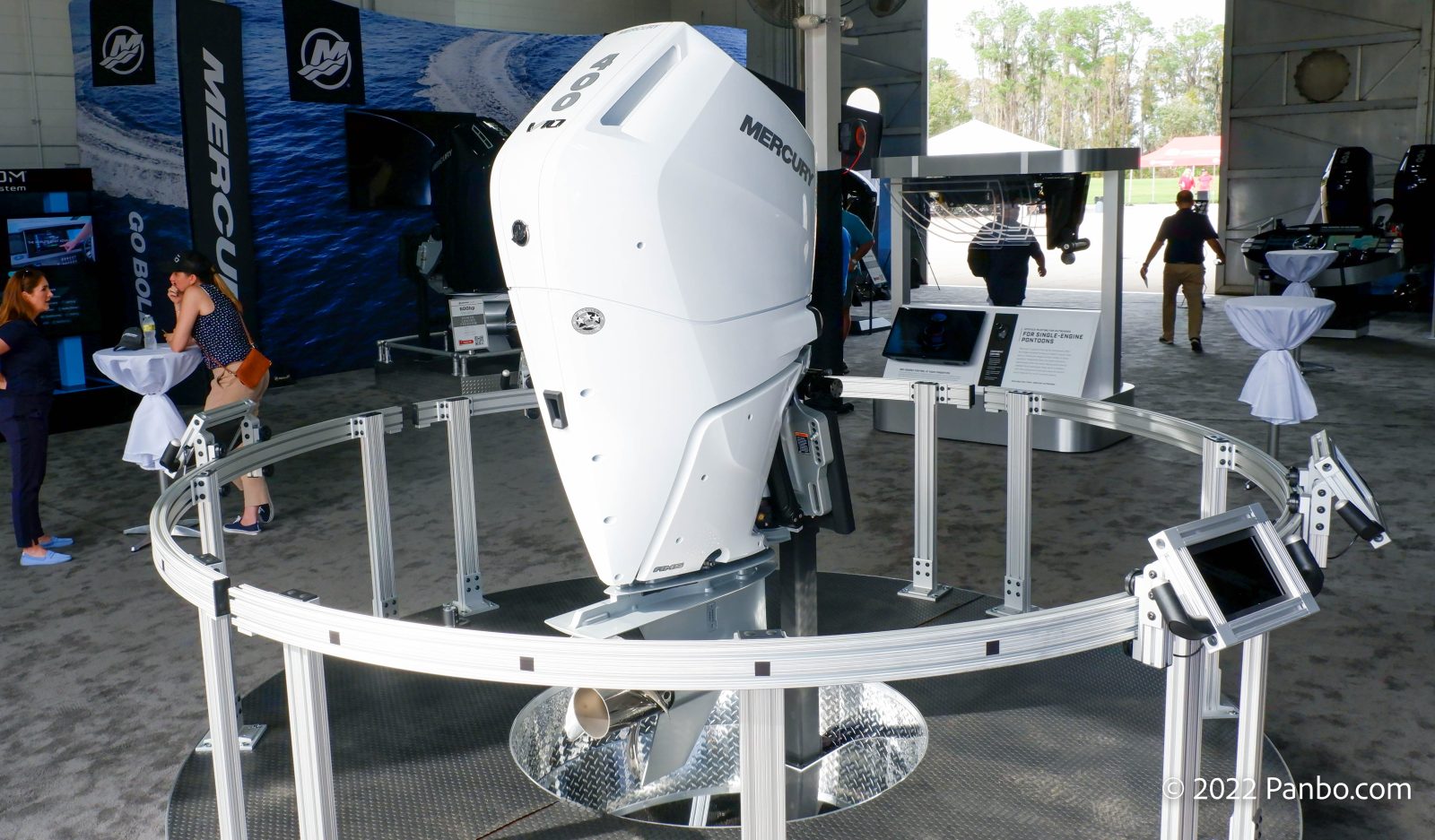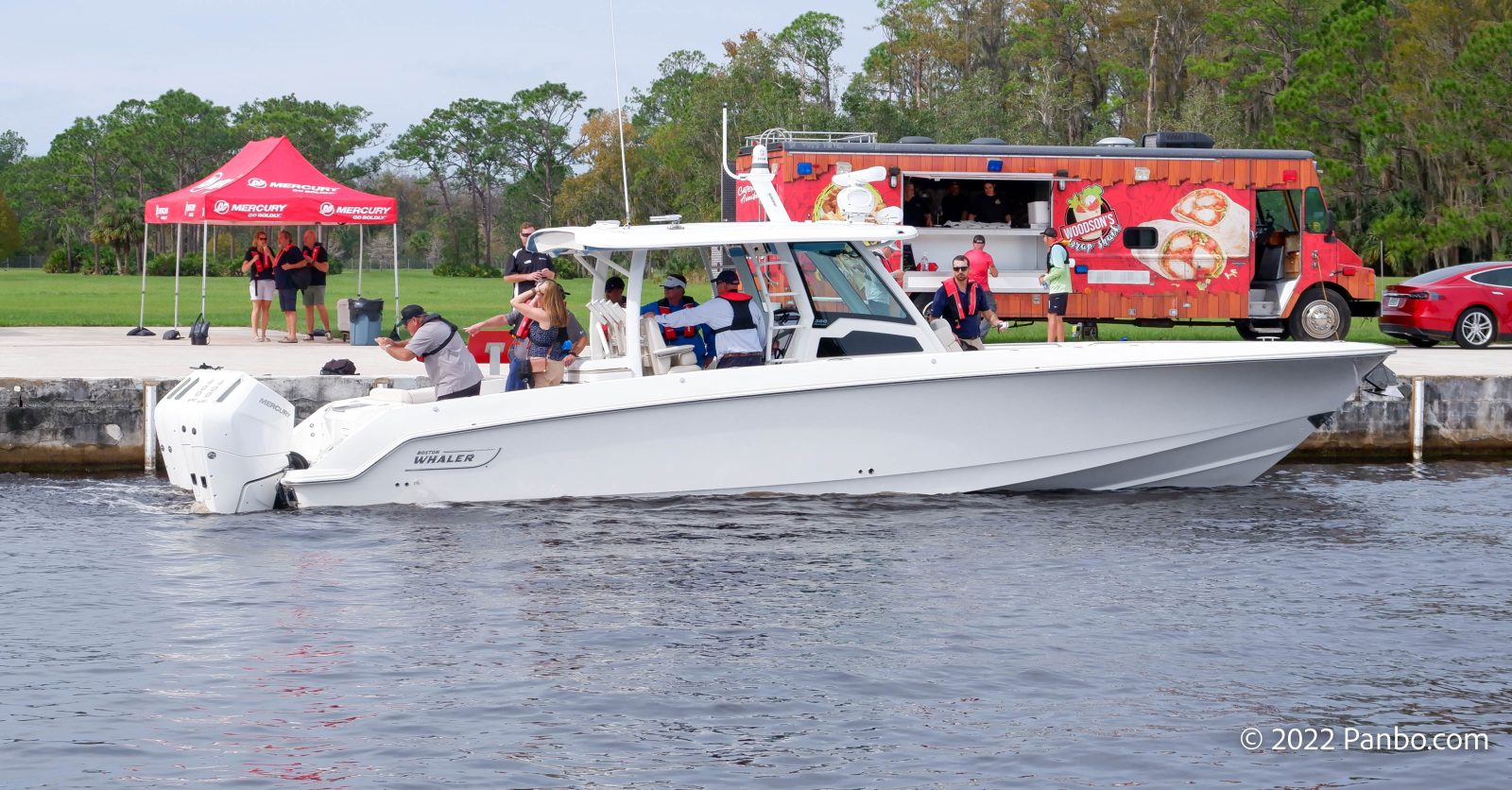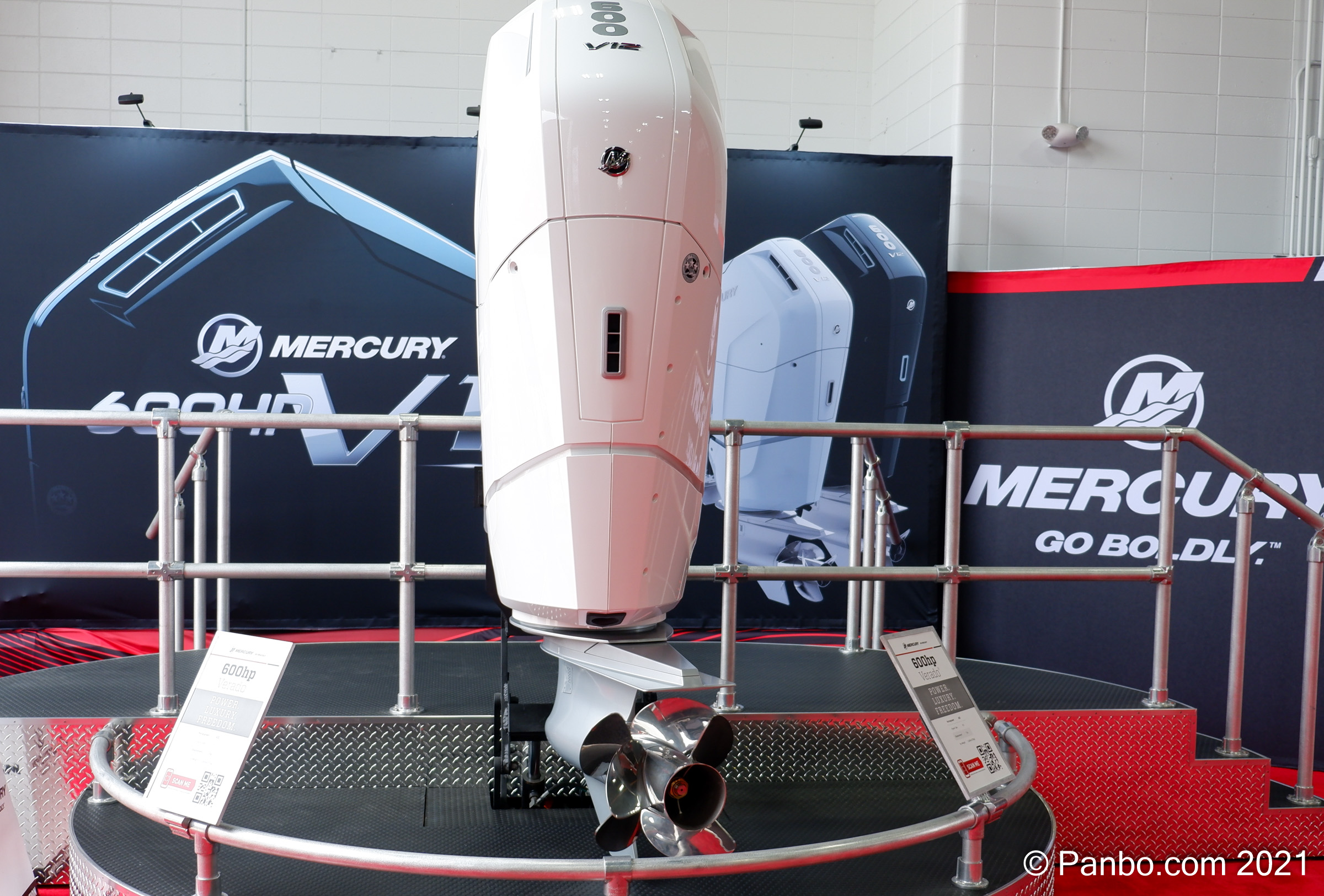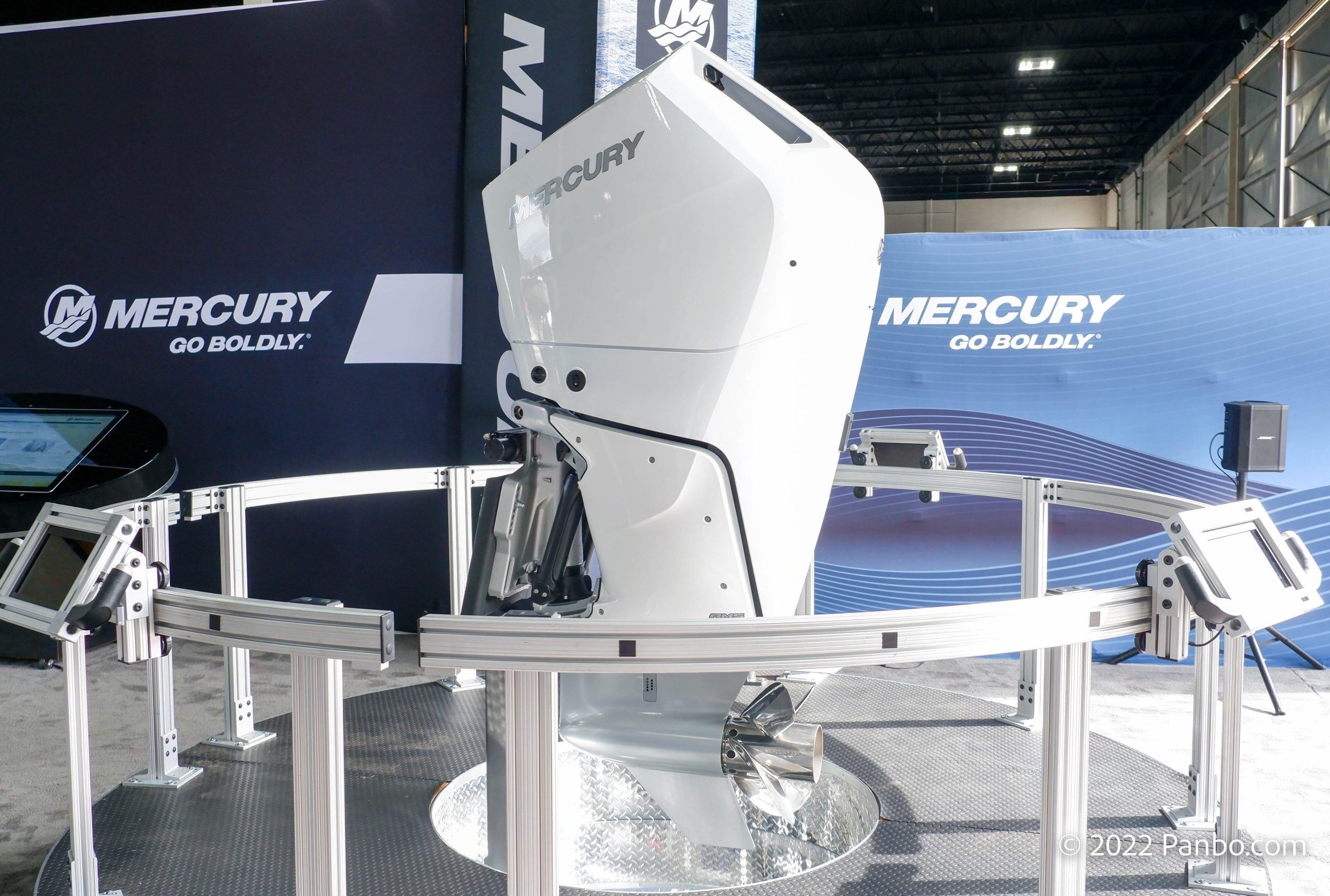Mercury unveils 350 and 400 hp Verado V10 motors, but the real story is the alternator!

This morning, Mercury unveiled their new 350 and 400 horsepower, Verado V10 engines. These engines follow the introduction of the highly successful, judging from transoms at the Fort Lauderdale Boat Show, Verado 600 horsepower, V12 engine. I’ve just spent the day at Mercury’s Lake X facility and I can tell you these are really impressive engines, but for many Panbo readers, that’s not the story. The story is the dual voltage, 12 and 48-volt, alternator!

Before we dive too deeply into the weeds of the alternator, let’s talk a minute about the V10 Verado. Coming on the heels of the 600 horesepower V12, the V10 delivers many of the same features in a smaller, lighter, and cheaper package. It lacks the two-speed gearcase, fixed powerhead, steerable lower unit, and mulit-plate clutch of the V12. But, at 697 pounds, it delivers more torque and refinement than any of the outgoing 350 and 400 horsepower options. In fact, it provides a level of refinement that’s hard to describe without firsthand experience. These are smooth, quiet, torquey, and high performing engines.
Now, back to the alternators. I’m not sure Mercury and Brunswick were ready for my barrage of technical alternator questions. Thus, I haven’t been able to get all my many questions answered. But here’s what I’ve learned so far. Also, a note, I’m planning much more in-depth conversations with the engineer responsible for this alternator in the near future. So, stay tuned for more details soon.
The standard alternator on these engines is a 150-amp, 12-volt unit. The engines are available with an optional 12 and 48-volt alternator. The 12-volt only alternator produces 150 amps or 1.8 kilowatts of power. I learned today that the dual voltage alternator produces less 12-volt power than the 12-volt only, but I’m not sure how much. When producing 48-volt power, it makes 6.5 kilowatts. At 48 volts and 150 amps, the alternator would output 7.2 kilowatts, so, it seems there’s some de-rating of the output, likely to manage heat.
The alternator can produce 12 or 48-volt power, but not both simultaneously. In my conversations with Mercury reps, I heard mention of activating additional coils to produce 48 volts. I think that means there are additional windings in the stator for 48-volt output that are only in play when the alternator is running in 48-volt mode. There are separate output terminals for 12 and 48 volts.
The engine will control revolutions to meet power demand, up to 2,000 RPMs. The ECU will track engine running hours separately for generator and propulsion loads. Mercury has done testing and says they’ve determined generator hours have a de minimis effect on engine longevity. I hadn’t thought about it, but tracking them separately seems like a very good idea.

The choice of 48-volt output from the alternator makes a great deal of sense. I’ve written about the case for 48-volts previously, as well as how one sailboat uses a 48-volt alternator and batteries to replace a generator. Brunswick is thinking along the same lines with their Fathom e-power system. This system uses Mastervolt’s MLi series lithium iron phosphate (LiFePO4) batteries, inverters, and other power conversion equipment to replace a generator.
Fathom has been available on several Sea Ray models for a few years. But, until now, these systems are really designed to use the engine’s alternators to slow the rate of discharge. There simply wasn’t enough alternator output to effectively charge the batteries from the engines. Instead, the plan would be to wait until the boat was back at a dock and recharge with shore power.

For perspective, let’s look at a Boston Whaler 380 Outrage, a 38-foot boat. I had the opportunity to take a ride on a quad-engined 380 today and experience what 40 cylinders can do moving 38 feet of boat around a lake. That was impressive, but even more impressive is output of the optional 7.5-kilowatt generator’s output to the V10’s.
If a buyer were to select four 48-volt capable motors, they would have 26 kilowatts of power available. Fortunately, it’s not an all or nothing proposition and you can mix and match 12 and 12/48 capable engines. Obviously, four engines, each capable of producing 6.5 kilowatts is overkill. So, it seems more logical to equip two engines with the 48-volt alternator and instead have 13 kilowatts of power available. That’s still a sublime amount of power available for a 38-foot boat.
Best of all, when 48-volt power is being produced, more of it can be harnessed than would be typical for a generator. Often, when a generator is running, it is very lightly loaded, which isn’t very efficient. But, becuase the power the engines produce is harnessed to recharge a large LiFePO4 bank, runtime in generator mode should be significantly reduced.
If you can’t tell, I’m quite excited, and very pleasantly surprised, about the alternator in these motors. 48-volt in boats has long seemed like a chicken and the egg problem. Many have been able to recognize the potential benefits of it, but also the difficulties. To date, there haven’t been enough 48-volt components available, and we haven’t seen mainstream builder adoption. Now, Mercury is advancing the cause of 48-volt in an engine that’s likely to see significant volume.
There is one thing potentially tempering my excitement. The 48-volt mode of these alternators is designed to be harnessed by Brunswick’s Fathom e-power system. It’s not clear if and how a non-Fathom system could leverage it. There’s nothing proprietary about 48-volt power, but controlling the output may require SmartCraft integration, and that might leave non-Fathom systems out.
I’m very hopeful that Mercury’s, and by extension Brunswick’s, inclusion of a 48-volt capable alternator will advance adoption. We need components including fuses, power distribution, bilge pumps, lighting, windlasses, and more. But, for these products to be developed, there needs to be demand.
I’m hopeful this entry into the world of 48-volt will create the demand needed to stimulate the development of 48-volt components. Only time will tell, but the support of a major player like Mercury certainly helps.













Ben,
You are right, the 48V charging is big news. Note that when considering the effective kW output of the alternators, that engine rpm will have have a great effect. Most likely the rated output will only be reached within a certain rpm range. Which would be interesting data to see…specifically an rpm/output graph of some sort. Perhaps you ask your Brunswick contacts if that’s available?
Bruce,
I’m hot on the trail of an output graph! I’m especially keen to understand both output at RPM and the ability to cool the alternator when the boat is stationary. I’ll definitely update as soon as I learn more.
-Ben S.
Interesting… but I guess I’m not up on current trends. By “generator mode”, are you referring to running a main engine(s) at anchor to recharge the house bank, as opposed to doing the same thing with a genset?
I’m having a hard time understanding how idling (or perhaps well above idle) a 350HP main engine, instead of a purpose built generator is any more efficient in this scenario, regardless of the alternator output voltage. Perhaps you could elaborate further?
Grant,
That’s definitely Mercury’s intent with this system. Brunswick has offered their Fathom system (marketing for large LiFePO4 bank, inverter, and integration bits) as a generator replacement on multi-outboard boats for several years. The idea has been that when the motors are running, they can either recharge the batteries or at least slow the rate of discharge. This level of charge capability turns that into the motors definitely recharging the batteries.
I’m waiting for specific numbers on the alternators output, fuel consumption in generator only mode, etc, but I’ve heard the number 0.6 gallons per hour in generator mode a few times. At 6.5 kw of output, that’s not out of whack with a generator’s burn rate. Plus, the idea is that you would only run the engines for relatively short periods of time, to recharge the batteries.
-Ben S.
So there is an automotive equivalent to this. A couple years ago Ford started offering a version of their hybrid F150 with the ability to use the hybrid engine driven charger and inverter to output AC power. 7.2 KW so similar to this. A few people ran testing on this and I recall it would consume fuel at a very similar rate as a high end gen. (usually within 10-20% ). It was also shown to be quieter then the gen. Basically;y at lower RPM where an engine develops lower HP it uses similar fuel to a smaller engine running at higher RPM and the losses from the additional rotational mass and friction are not as high as they used to be with modern engine design.
Here is one test.
https://www.evpulse.com/features/for-science-fuel-consumption-of-the-7-2-kw-pro-power-onboard-generator-in-the-2021-ford-f-150-hybrid
Hmm, OK thanks Ben. I suppose eliminating the space and weight that a genset takes up is worthwhile. It would seem this is only going to be practical in a certain size-range though. I’m thinking there are other issues to address – noise, for one. But I’m sure the engineering experts at Brunswick are all over this. The alternator definitely seems to be the critical piece of the system!
They mentioned something about electronic power steering, no hydraulics, any word on that?
Is the alternator driven directly from the crankshaft or via a belt and pulley system? It is hard to tell from the photograph.
Jim,
I recently confirmed the alternator is belt driven. It’s a stretch-fit belt without a tensioner.
-Ben S.
7kw? I could see something that small producing 30 amps at 48 volt, but 150 amps at 48 volt? At what rpm? And how are they cooling it? I think someone has their volts and amps mixed up. I could see if keeping up with one 7000btu ac air conditioner through an inverter but not like four!
In the long run what is needed are 48v dc appliances, refrigeration, air conditioning, windlasses, engine starters, stoves/ovens etc. Much simpler system and efficient system vs dual voltage, and ac appliances that require inverters. No shore power required other than to power the 48v dc charger.
No amps or volts are mixed up. The output is 7.2kw at about 3,000 RPMs. The stationary output of the alternator seems to be about 5kw continuous output.
-Ben S.
Cruise N Comfort USA has been producing 48 Volt DC marine air conditioning for its commercial and military customers for 2 years now. Really cool seeing these charging systems putting out decent power.
Anybody have a Part Number for the new 150amp 12v alternator?
I realize the original post was a couple years ago, but I have a question that I haven’t found an answer to elsewhere:
I’m looking at a new boat that has a pair of these Verado 400s with 150A alternators. There’s a 24 kWh lithium bank with a pair of Mastervolt inverter/chargers. Mercury says that the alternators make full rated output at 1500 rpm.
Historically I have owned trawlers with diesel generators sized for the charger capacity. In this case the alternators would be acting as the generator, but it’s unclear to me how long I can run outboards at 1500 rpm if I’m just using them to charge. It would seem like they would be way under loaded.
Any input is appreciated!